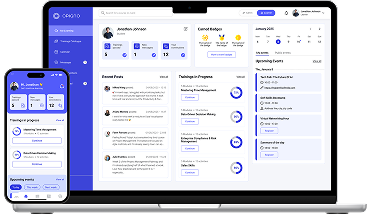Even the most perfectly designed courses have a shelf life. No training stays relevant forever; plus, making the most of existing materials is far more cost-effective than constantly creating new courses from scratch.
Some updates are obvious — logos, factoids, or outdated terminology need occasional refreshes, retired file formats (like Flash) should be replaced, and changes in industry standards, technology, or company processes should be reflected. But determining whether a course has lost its effectiveness is much trickier. A course might look fine on the surface while failing to deliver results.
Watch for these warning signs:
- Learners show no improvement
Assessment results remain unchanged pre- and after the course, and employees still face the same challenges. - Lack of engagement
Low completion rates, negative feedback, and disinterest indicate the content is irrelevant, unmotivating, or poorly designed. - Learners don't apply training
If training doesn't lead to real-world improvements, it may be too theoretical or poorly structured. - Outdated formats
Training that isn't mobile-friendly or interactive can limit accessibility and effectiveness.
Once you spot these issues, what do you do with the content?
Update, replace, or delete?
Not all outdated content requires the same level of intervention. The right approach depends on how well the material still serves its purpose.
Review the content carefully. A quick update is enough to keep it accurate if a course is still relevant but has minor inconsistencies, like outdated figures, terminology shifts, or company branding changes. For instance, a compliance course might still teach the right regulations, but if it refers to a discontinued software system, a simple wording adjustment will do.
A more involved revision is needed when content remains valuable but feels outdated. A product training module might include old SCORM files, passive slides, or static PDFs that fail to engage learners or don't work well with modern devices. Replacing sections with interactive content and updated media can refresh the experience without rebuilding everything from scratch.
If a course's core content no longer aligns with current needs, methodologies, or business strategies, and fixing it would take as much effort as rebuilding from scratch, it's time for a complete overhaul. For example, a leadership training program based on outdated management styles or a sales training course focused on products that have evolved significantly might need to be restructured entirely.
And then there's content that's simply no longer relevant — think training for retired policies, discontinued software, or roles that no longer exist. Deleting it prevents learners from wasting time on obsolete material. That said, useful elements, like strong explanations or clear infographics, can be recycled for future use.
The key is not to wait until ineffective content disrupts training. A structured update process helps keep everything under control and prevents issues from escalating.
Streamlining LMS content upkeep
Rather than scrambling to fix problems after they surface, a proactive approach ensures you can keep content effective and relevant without unnecessary effort:
1. Set clear objectives and roles
Before touching any content, define what your training should achieve and who is responsible for it. Establish learning objectives tied to business needs to have a solid benchmark for evaluating course effectiveness. Assign clear roles and responsibilities for reviewing, updating, approving, and retiring content. Set approval chains to keep decisions efficient.
2. Catalog your content and track changes
Maintain a structured inventory of all courses, modules, and assets, complete with creation dates, update history, and logs of previous changes. In Opigno LMS, the admin dashboard provides a full overview of training content, making it easy to track when content was created or modified.
3. Map content to objectives and set a review schedule
Assess whether content still supports learning goals and categorize it into quick fixes, moderate updates, and complete overhauls. Establish a regular review cycle based on relevance, complexity, the time you have on your hands, and business impact (the impact/effort matrix can be helpful here).
On top of the regular schedule, define ad hoc review triggers, such as performance gaps, compliance changes, or repeated learner feedback, so urgent issues get addressed promptly.
4. Use data and collaboration to guide decisions
Throughout the process, track learner engagement, assessment scores, and feedback to identify underperforming content. Keep instructional designers, SMEs, and trainers in the loop to ensure content remains accurate and engaging.
This approach makes content maintenance a manageable, ongoing process rather than an overwhelming task. Instead of scrambling to fix outdated materials, you'll always have a structured, up-to-date learning ecosystem.
Keep your training sharp with Opigno LMS
Outdated content creates frustration, disengagement, and wasted learning time. The best way to prevent this is by keeping content fresh and relevant, which is challenging when handled manually.
Looking for a platform that takes the hassle out of content management? Opigno LMS puts you in control with intuitive dashboards, structured workflows, and automated localization. Book a personal demo to see it in action.
Published on February 25, 2025.
